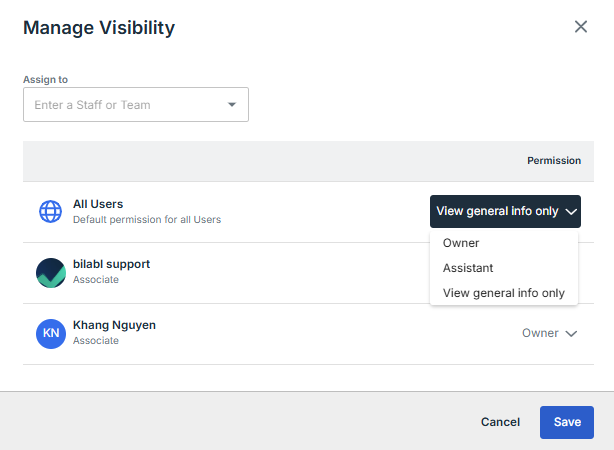User Role and Entity Permission
In this article
In bilabl, permissions govern what data users can access and the actions they can perform. These are managed through two primary components: user roles and entity permissions on clients and matters. Together, they define a user’s access and capabilities within the system.
- User roles: Control access to firm-wide data and available actions in bilabl. Roles range from limited to full system control.
- Entity permissions: Specify what a user can view or do with individual clients or matters, such as editing or deleting.
Permission overview
User roles
bilabl offers six user roles, each with specific permissions:
- User: The default role for most employees. Users can only view and work on assigned clients and matters.
- HR: A role for HR team members. HR users can add and manage user accounts, except for Administrator or Manager accounts.
- Accountant: A specialized role for financial and accounting teams. Accountants have access to all timesheets and billing data based on entity permissions.
- Manager: Grants full access to all data across the system.
- Administrator: Grants full access to all data and the ability to modify firms’ settings.
Notes: Team leaders inherit their team members’ permissions, allowing them to view and edit team-assigned clients, matters, and timesheets.
Entity permission
Entity permissions define a user’s access to specific clients or matters. There are three types:
- Owner: Full control over assigned clients or matters, including editing, deleting, and adding billing.
- Assistant: Can contribute to assigned clients or matters but with restricted actions (e.g., cannot edit or delete).
- View general infor only: Have the limited visibility or access to the client or matter.
Permission inheritance: Matter permissions are inherited from client permissions. For example:
- A client Owner is automatically an Owner of all matters under that client.
- A client Assistant is an Assistant for all matters but can be granted Owner permissions for specific matters.
To determine a user’s full access, check their entity permissions for the specific client or matter.
.jpg)
Permissions details
User role
The tables below provide a detailed overview of the actions available to each user role across key areas.
Entity permission means that it requires the permission of the user on the specific client and matter (e.g., Owner or Assistant).
Timesheet permissions
Client permissions
Matter permissions
Billing and payment permissions
User management permissions
Settings permissions
Team leader permissions
The Team Leader role in bilabl allows users to manage their team’s clients, matters, and timesheets assigned to both themselves and their team members. This role extends beyond standard User permissions by inheriting team members’ Entity Permissions (Owner, Assistant, or View General Info Only). The table below outlines the specific actions Team Leaders can perform across key system areas.
Entity permission
The table below outlines the actions available based on a user’s entity permission type for a specific client or matter.
Notes:
- You cannot delete a client with open matters.
- You cannot delete a matter with time/cost records.
How to manage permissions
Managing user roles
To assign or modify a user’s role:
- From the top navigation, go to the People page.
- Click Edit on the specific user from the list.
- Navigate to the User roles section on the user edit page.
- Select one or more roles for the user.
- Click Save to apply the changes.
Tips: Users can have multiple roles, but bilabl displays the highest role next to their name (e.g., a User and Team Leader will appear as team leader).
Managing entity permission on client and matter
Only Administrators, Managers, or Owners can assign entity permissions:
- Search for the user you want to assign.
- Select the user and mark them as Owner or Assistant using the respective radio button.
- Click Save to apply the changes.
In bilabl also applies automatic rules to grant access to clients and matters. You can view these users in the Other People Who Can Access This Client/Matter section:

- Team leaders gain access when their team members are assigned.
- Client creators are automatically assigned as owners.
- Matter access is inherited from client permissions by default.
For further assistance, visit the bilabl Help Center or email support@bilabl.io.


